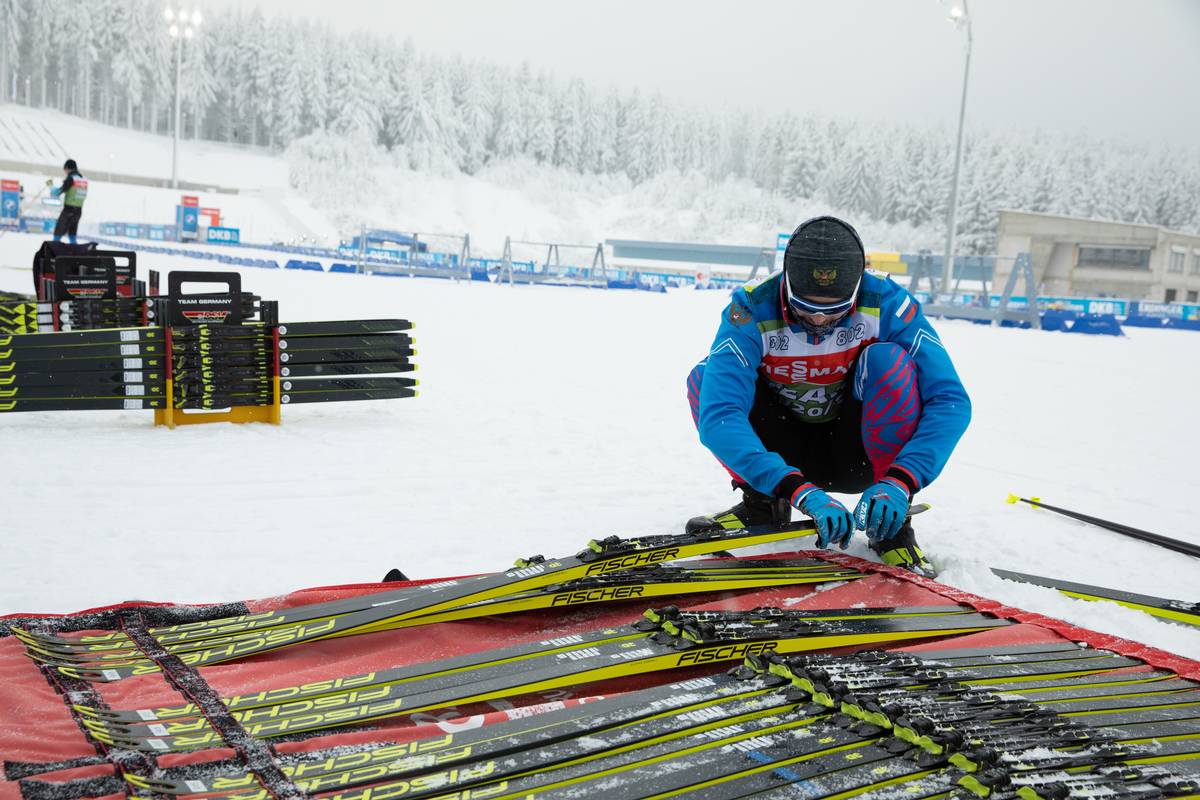
With great pride, I will admit to being an unabashed fluoro powder addict. After finding an affordable source of the stuff (200 grams for $50.00) my use might be considered reckless. I have unapologetically sprinkled powder on skis with the same vigor and arrogant nature as Samuel L. Jackson drops F-bombs in Tarantino films. Powder made my skis slick and fun. I LOVE the feeling of dusted sticks. I also love the planet and realize my careless use must come to an end.
This season the powders were tucked away and not disposed of hoping there was an error with the science and we can eventually use them again. My skis only came in contact with hydrocarbon waxes without any fluoros. Quite frankly, the skiing sucked. The boards were slow and had no life to them. Skiing wasn’t fun so I basically stopped, choosing to ride my Peloton instead. In this post-apocalyptic dystopian era of no fluoros, I missed skiing but not the associated sluggish feel of hydrocarbon wax.
Banning the use of fluorocarbons in skiing was a difficult decision by FIS. As you probably know, they too are equivocating. By definition, speed is a requirement for racing. Speed is exciting to experience and it’s fun to watch others go fast. Taking a stand to legislate the ban of a speed device (fluoros) to help ensure the long-term wellbeing of planet earth supersedes the short-term gains of ski racing speeds is commendable and admirable. Eliminating fluoros has the real potential to make cross-country ski racing slow and as exciting as watching grass grow. By eliminating a component contributing to speed, there is a real possibility to kill off the sport.
Eliminating fluoros also has the potential to unlock an era of innovation and creativity. Waxing technology has remained pretty much unchanged for decades. After waxing reached a stagnation point considering it’s contributing to speed, innovative thinkers took another look at base friction and determined the structure of the base was the next untapped well of speed.
Now, another group of innovators is taking a look at ski bases. Instead of focusing upon grinds, this group of tinkerers is examining how to manipulate the bases electronically to enhance glide and generate speed. After hearing rumors this past summer, Fasterskier spent the better part of the winter working to obtain an interview with this group of forward thinkers. We finally caught up to them. Once the patents were applied for, these disruptors were granted the opportunity to present their idea to the ski world. Here is their story and begins with a quick explanation of waxes.
***
“The concept is actually really simple.” begins Vanessa Taylor, one of the chemists working on the project. “In order to glide, a ski needs a thin film of water to lubricate the plastic base. Unfortunately, the water also sticks to the base without using wax. The friction caused by water molecules dragging along the base leads to viscoelastic energy dissipation. The water also adheres to the ski bases due to static electric attraction which causes the dreaded suction we use grinds to overcome. The wax essentially insulates the base from the water and has a higher repellency allowing the water to act more like a ball bearing than grease. fluoros are extremely hydrophobic and have more influence reducing the stiction caused by the electromagnetic attraction of the plastic.”
Taylor walks across the room to a stainless steel table. A series of wires hang from an overhead gantry. At each end of the table sits a metal box with pink string coming out from a vertical slit in the face. At the end of the string is a small snap swivel similar to what a fisherman will use to attach lures.

“This,” Taylor waves her hand like a magician introducing a prop “is the testing table. We take sections of ski base and attach the string to either end. Then we set a 2 kilogram weight on top to simulate a skier during a glide. One box winds in the string and the other pays it out. We know the force required to break the initial movement and the force loss due to friction based upon the wattage needed to turn the motor. The payout string gives a measured resistance to pull against.”
She takes a common spray bottle and applies a thin film of water to the table. “The water field on stainless is a decent simulation to test the efficacy of ski waxes and our product. The basses are also set flat to eliminate the variability of flex and crowning. We grind a specific pattern into the base too. We eliminate the variable of snow conditions to obtain data on the glide.”
Each sled is 20 cm. long and she attaches one to the table by the strings and connects one of the umbilical wires from the gantry. A click of the laptop and the sled begins its journey down the table. “There we go. 152 watts. This was unwaxed P-tex. Now let’s run fluoros.”
The setup is the same and after the test run the number is 84 watts. A significant change.
“Now let’s run our idea.” The result is 51 watts. I’m astonished. “Pretty wild, eh?” She asks.
“What type of wax have you developed?”
“Not wax but bases. We use a small electric charge in the base to repel the water in place of the wax.”
“Wow.” Is all I can muster. “Is this legal?”
“The FIS race rules are a bit ambiguous on this point. The rules outlaw accumulators (bracketed by air quotes) but allows energy originating from the competitor. [For a closer see the excerpt from the FIS rules below]
“At first we were going to go after the race market. We incorporated small piezo generators, similar to the clicker used to ignite a gas grill, into the bindings. This gave us enough current to power the base but the need for a storage device to carry the effect on long downhills was problematic. We are abandoning the race market for now.
“The focus will be on making recreational skiing fun. Plus, it’s actually a much larger market with the added bonus of no rules. Battery technology is making rapid advances too. Just pop a small battery into the ski and have at it. Bicycles are embracing E-technology and we intend to bring this to snow sports.”
We leave the test room and move to the R&D portion of the reconditioned barn they call HQ. The sign above the door reads “Fearless”.
Inside we meet William Gordon, the man who first thought electrifying skis might be possible. He tells me the story (which has been edited for brevity, William can talk) of watching snowflakes align themselves on a cutting board being used for insulating an old aluminum lugged carbon fiber bike frame.

“We were TIG welding an aluminum lug on a real old, Time carbon frame. To insulate the carbon from the welding table, we used a plastic cutting board (made from UHMWP the same stuff as ski bases) to keep it from conducting the electricity used to weld. The TIG process for aluminum uses alternating current and we can alter the frequency and how the sign wave is delivered to the metal. We were jamming in Joe’s garage during the winter and it was snowing. Each time Joe struck an arc I noticed the snowflakes begin to move around the plastic. At first I thought it was vibrations causing them to dance but soon realized the flakes were being repelled and levitated by the welding process. When the flakes melted, the droplets did the same thing. Just like you, I like to ski and use fluoros like some people put salt on popcorn. With them going away I needed something to keep skiing fast and fun. What if I can put the same properties I saw on the welding table into a ski base? Might be a workable idea.”
“I thought the plastic was an insulator?” I ask William.
“It is for transferring current but this doesn’t mean it won’t hold a static charge. Wax companies add graphite to create a small static charge created by friction with the dry snow. We do the same thing by electrifying the bases.”
William brings me to the back corner of the room where a 3D printer is set up. Spools of carbon fiber thread move through a series of loops to a small CNC head where they split apart into much smaller bundles.
“We use the printer to incorporate carbon fiber into the bases. The carbon is conductive and is used to carry the impulses from the processor located inside the ski. We found running the frequency at a bit over 200 hertz makes the best glide. There are over 300,000 individual circuits in each base. Right now, the process is very slow. We are working on getting it automated and simplified. We are currently hiring a few engineers from the semiconductor world to help us make the transition from a single base each week to hundreds per day. We also have to scale the processors and batteries to fit inside the ski. Weight and how the ski feels are just as important as glide.”
My mind is a bit numb trying to get a handle on what these guys are doing. How it all works is as mystifying as why waxes make skiing more fun. His next revelation sounds counterintuitive and unbelievable even by comparison to the E-ski concept.
“We can also reverse the repellency and cause the skis to stick. The attraction is pretty small but for classic skiing, we have the entire base grab onto the snow. It works, but achieving the same classic ski feel is tough. We tried putting force sensors into the binding to activate the grip function. When it works, it’s great but it is more unreliable than hard wax right at the freezing point. Something to work on.
“We have also played with the idea of alternating the pattern and alignment of the static discharge points to act as a small motor to actually propel the ski. If we nail this, the E-ski will really shine. Right now it works but requires a lot of power and processing. So much we couldn’t get it all into a backpack. What we have figured out given the restraints of the ski based system is how to slow down the ski. We use the same idea to act as a brake to slow the ski. We Bluetooth connect it to the ski pole and then you can apply stopping power. We hope this will reduce the snowplowing and save the snow, require less grooming, etc. Saving the limited snow is also a benefit to the environment. My wife suggested making brakes as she hates fast skis. They scare her. We asked a few recreational skiers if this was a good idea and they LOVED it.” Gordon threw his head back and laughs. “Ironic isn’t it. We were trying to make skis faster and the big application is using the technology to slow them down.”
“This all sounds great but when can I get a pair and will the skis have the same feel as using fluoros?” My eagerness and self-interest are difficult to hide.
Vanessa chimes in. “We have proven the concept and are seeking investors to develop the idea into a practical application. We have been filing new patents almost weekly. If the funding comes through we expect to be selling skis for the 2022 season. When we have some production-ready skis we’ll send a few pairs to FasterSkier for you guys to review.”
The rest of the tour was confidential, having to do with proprietary manufacturing techniques. Will the E-ski revolution have the same impact as the E-bike? Time will tell and I’m excited to know the fluoro ban has ignited a host of innovations. This is exciting and we’ll keep you up to date on the progress of the E-ski.
FIS rules with respect to legal skis:
- Cross-Country Skiing Competition Equipment 1. General Rules The following rules apply to all type of Cross-Country competition equipment such as skis, bindings, boots, poles and any additional equipment. 1.1 Restrictions No equipment is permitted which: a) Affect the natural push-off movement of competitors’ feet and arms or those that enhance it (such as spring devices or other mechanisms in skis, poles, binding or boots). b) Makes use of energy not originating from the competitor, such as artificial heating devices, chemical energy accumulators, electric batteries, mechanical aids, etc.).



